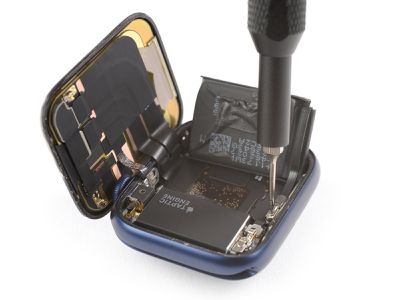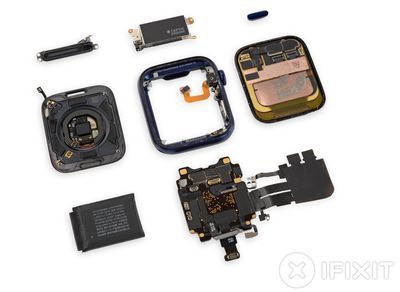iFixit today did one of its traditional teardowns on the new Apple Watch Series 6 with GPS and LTE, which became available for purchase last Friday. While the new Series 6 models look quite similar to the Series 5 models externally, it turns out there are quite a few internal tweaks and modifications to support new features like Blood Oxygen Monitoring.

The new Apple Watch models open up like a book much like the iPhone rather than from the top down like prior Apple Watch models. Since Force Touch has been removed, there is no Force Touch gasket component, which makes it easier to tear into the new Apple Watch models. iFixit also found fewer cables for a more streamlined design that offers easier repairs.
Apple is using a 1.17Wh battery in the 44mm Apple Watch Series 6, which is just a slight increase (3.5 percent) over the battery used in the prior-generation Apple Watch Series 5. That should come as no surprise as the Series 6 continues to offer the same 18-hour "all-day" battery life as prior models. The 40mm model, which iFixit also took a look at, has a 1.024Wh capacity, an 8.5 percent increase over the 40mm Series 5.
There's a larger Taptic Engine in the Apple Watch Series 6, and the frame has been slightly modified with a narrower lip for adhesive. This tweak, along with the removal of Force Touch, may be why this years's models are just a bit thinner (10.4mm vs 10.74mm).

The display is fused to the top of the casing and the sensor array, updated with new sensors for Blood Oxygen monitoring, is fused to the bottom.
All in all, iFixit was impressed with Apple's ability to pack new sensors, a larger capacity battery, and a bigger Taptic Engine into a thinner casing.
They just keep polishing this thing to a higher and higher gloss and it's almost sneaky how much of it they don't tell you about, keeping all the focus on the whiz-bang health features.
The 2020 Apple Watch Series 6 ultimately earned a repairability score of 6 out of 10 thanks to the easier screen replacements and battery replacements, but there are still tiny tri-point screws to manage and the flex cables mounted directly to the S6 package require skilled microsoldering if an accidental tear occurs.























